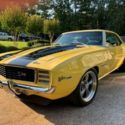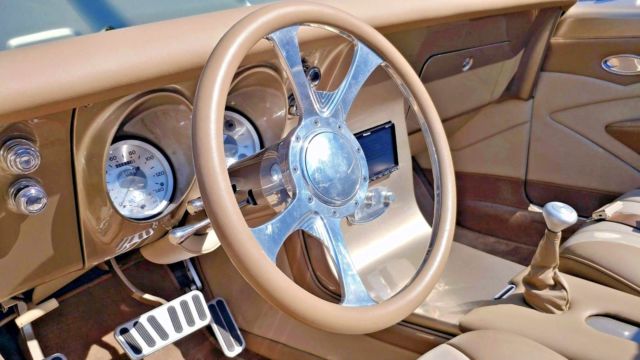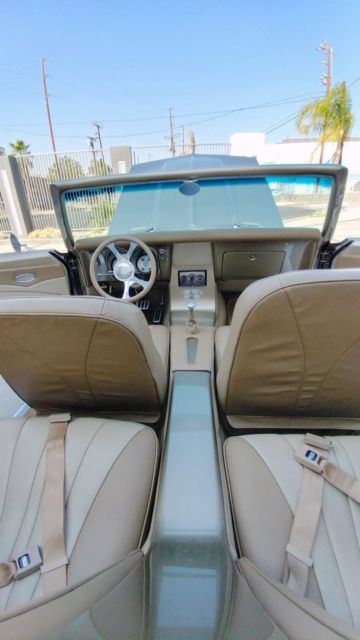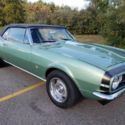A Clydesdale Styled Fully Customized 1967 Chevrolet Camaro Hot Rod
- Location: Pacoima, California, United States
- Condition: New
- Make: Chevrolet
- Model: Camaro
- Type: Convertible
- Trim: Custom
- Year: 1967
- Mileage: 932
- VIN: 51833
- Color: Custom Design
- Engine size: ZZ383, Inglese 48IDA
- Number of cylinders: 8
- Power options: Air Conditioning, Cruise Control, Power Windows
- Fuel: Gasoline
- Transmission: Automatic
- Drive type: RWD
- Interior color: Brown
- Drive side: Left-hand drive
- Options: Hot Rod, Blutooth, XM Digital Nav, GPS, Roadster, Leather Seats
- Vehicle Title: Clear
1967 Chevrolet Camaro Custom Description
QuestionsIf you have any questions at all, please don't hesitate to call (818) 254-7190
The StoryThe following was an article written about the creation of this Hot Rod that was featured in the 2010 edition of Camaro Milestones. It highlights details about the car, and the 3 year and over $200,000 journey it took to build this modern classic masterpiece of customized motorized engineering.
--
Inspiration for the look of a project car can come from all sorts of places. Vehicles have been customized to look like everything from a James Bond spy car to a favorite orange soft drink. But Richard and Helen Fripp chose something a bit more personal for their 1967 Camaro.
You see, they not only appreciate horsepower, but also horses - in particular, their imposing Clydesdale named "Captain Crunch", for his oversized, hair-covered hooves and stomping gait. Turns out there are more than a few similarities between this Clydesdale and her Camaro, as Helen's hot convertible lays down a big "footprint" when she stomps the throttle.
Some onlookers think those are flame graphics on the sides, but they actually represent the Clydesdale's flowing mane. Take a closer look at them, and notice how they recess into the main body color, rather than being laid on top like most licks.
"I didn't like the look of typical flames," she explains. "Instead, it's like the base color is purple, and the Cashmere body color was applied over it." (By the way, "Cashmere" is her nickname for the Camaro, but not due to the beige body color - it's from the name of her favorite perfume.)
Richard, an electronics engineer by trade, has always had a knack for catooning in his spare time, and worked up the initial drawings of the graphic. He didn't expect her to go that far with the theme, "But it's her car," he acknowledges. And he gives her credit for all the creative touches that went into it.
Taking the Camaro/Clydesdale comparison even further, the breed had been known for hauling heavy loads, right into the 1960s when they were still a familiar sight pulling the carts of milk and vegetable vendors. Well, this Camaro is no Budweiser beer wagon, but it does have a lot of horses under the hood, thanks to a ZZ383 mill, fed by an Inglese 48IDA carb and manifold package. "Old carbs have a sound that's different from electronic fuel injection," Richard says. "We like that old Sixties sound."
Helen knows a thing or two about horsepower - just ask her about that triple-digit drive in a Thunderbird when she first met Richard. But she wanted something different, something subtle ("To hide it from the cops!" she admits), rather than a big blower sticking up through the hood. Captain Crunch can stand out from the crowd, but she didn't want as much attention on her Camaro - except when you open the hood. Fitting on the gleaming Inglese 48IDA induction system required elevating the intake manifold and some custom porting to work in concert with the ZZ383.
For those not familiar with the 48IDA, the number "48" indicates the system has a 48mm bore diameter and throttle plate, while the IDA suffix indicates that this is a high-performance downdraft carburetor. Its design looks more exotic than, say, Holley or Rochester carbs, but it's actually comparatively simple, with no metering rods or power valves. It's also constructed with rubber seals or plastic parts, the accelerator pump and floats are made from brass, and its throttle shaft rides in roller bearings.
The Inglese 48IDA can be made to work with nearly andy displacement or compression ratio by using interchangeable venturi that permit them to be turned to flow as much CFM as your engine requires. Even so, getting them to work right cab require the touch of a maestro. "We had to find a Ferrari multi-carb guy to tune them who uses dual CO2 testers on the exhausts," Richard points out. "Everybody asks if we have problems, but not after having them set properly."
In this particular engine application, the ZZ383/425 features GM's legendary Fast Burn cylinder heads, feeding 383 cubes for a muscular powerband with a torquey yet smooth delivery - basically big-block power in a small-block package. With as much as 425 horses at a low 5400 rpm, and 460 lb-ft of torque at 4500 rpm (with a 750cfm carb), it's an ideal choice for a a Camaro with the strength of a Clydesdale. Helen tells everyone, "Even grandmas can hot rod too!"
The ZZ383/425 gets a stout .509/.528 lift steel camshaft with 222/230 duration at .050 lift. Hydraulic roller lifters and GM's time-tested 1.5 to 1 roller rocker arms round out the valvetrain, fitted with lightweight stainless steel valves and retainers for reliable performance at extended high revs.
The internals are as tough as a plow horse, too. The 3.800-inch stroke of the forged rods swing a 4340 nitrided and induction-hardened crank. The 9.6:1 compression ratio ensures the ZZ383/425 can accommodate 92-octane pump gas.
Adding some show to the go, it's dressed with a Billet Specialties Tru Trac pulley system and Detroit Speed accessories. Be Cool's radiator and fan system keeps the block from boiling over.
Monitoring the engine's vital signs is a set of one-off Classic Gauges. During the build, Helen saw a speedometer face that she liked very much, but a four-inch gauge cluster that matches the speedometer was not available. So she requested Classic to make the gauge pack to match the speedometer size. Even though this special order cost a few extra bucks, the match looks just right.
This Customizing of the interior was just the beginning. One of the shops the Fripps worked with was surprised by all the mods they had in mind. You see, originally the car was a six-cylinder three-speed, an old nag ready for the glue factory. But Helen spotted this aging thoroughbred and didn't want to put it out to pasture. After noticing the poor fit of the ragtop and tiring of cleaning the windows (a regular task in the dusty dessert of northern Nevada), she decided to transform it into a roadster.
Extending that process to a logical extreme, Helen decided the back seats should be similar to the early-Sixties Corvette, closing off all door windows and wrapping the doors to conform to the newly-designed rear deck. She also wanted to have rolled padding for the door tops. This phase required reworking the shape of the doors so they flowed evenly into the rear deck. If the interior stopped at the doorframe, it would harm the overall look of the custom body design. So the rear seats were molded into fiberglass frames and then set into the vehicle.
Showing some proper restraint, though, she didn't want to change the bodylines, and elected not to install a wing on the trunk lid in order to keep the original shape smooth.
Helen didn't like the old-school suspension, so she elected to install the TCI Tubular suspension with billet coil-over shocks and anti-rollbar, plus a ford 9-inch rearend.
The front suspension clip features double rail, mandrel-bent tubing for increased rigidity to maintain optimum suspension geometry, along with better durability. The A-arms flex less thanks to stiffer urethane bushings, and the spindles drop the ride a couple inches. A GM disc-break setup is normally included but the "whoa" on this wild ride comes from Wilwood's 11-inch disc binders, and Flaming River's steering column guides the new manual rack and pinion.
The engine mounts, core support, body mounts, and suspension brackets come installed on the TCI package, all heli-arc welded. While Helen's car has a mouse motor that roars, the engine mounts can handle a big-block rat motor, as well as LS1 engines (with optional brackets and different oil pan). The TCI package includes a bolt-in transmission mount, and Helen opted for GM's 4L60E overdrive unit.
Once fitted with a modern suspension system and Street Star billet rims (18 x 8 front, 18 x 8 rear, shod with BFG's G Force KDW tires), "It feels more like a go-kart than a Camaro," Richard smiles, noting the early Camaro's well-known tendency to wiggle in the rearend. The first time Helen took it on the road, she was so enthusiastic about her new ride that she suddenly lifted her hands off the wheel at 75 mph! Her enthusiasm nearly have Richard heart failure, but he says she's been that way since their teenage years.
To keep her entertained on long road trips through the Nevada desert, the audio system is a Pioneer AVIC-Z2 unit with an HDD multimedia navigation server, driving a brace of ARC Amps and another pair of ten-inch subwoofers. Painless Performance replaced the factory wiring with a modern, pre-bundled harness with spade connectors that cleaned up the installation, ensuring a pain-free connection for the tunes. As for accessory switches, door handles, shifter and other hardware, most of these were provided by Lokar and Detroit Speed.
Perhaps even more rewarding than the numerous "Best" trophies given to Cashmere was the personal signature of renowned car customizer Chip Foose on the subs and amps in the trunk. He also added some deft sketches of Helen's Camaro and Richard's 1938 Chevy pickup.
The crowd reactions at show also mean a lot to the Fripps, even though hardcore Camaro guys occasionally question the level of customization.
"People do a double take when they realize it's a roadster, not a convertible," Richard says. "They stop and stare, and then bring back a bunch of their friends."
The best part, though, is that after three long years of building the car, Helen can really dig in the spurs for one wild ride!
 BEAUTIFUL Fully Restored Fully Sorted 1967 Chevrolet Camaro RS Coupe 327/Auto !!
BEAUTIFUL Fully Restored Fully Sorted 1967 Chevrolet Camaro RS Coupe 327/Auto !!
Mileage: 58,242
 1969 Chevrolet Camaro Rallysport Tremec 5 speed Pro Touring styled car
1969 Chevrolet Camaro Rallysport Tremec 5 speed Pro Touring styled car
Mileage: 21436
 1973 Chevrolet C10 Custom Deluxe - Fully & Tastefully Customized
1973 Chevrolet C10 Custom Deluxe - Fully & Tastefully Customized
Mileage: 96,000
 1994 Chevrolet Suburban 6.5 Turbo Diesel 4X4 fully loaded customized
1994 Chevrolet Suburban 6.5 Turbo Diesel 4X4 fully loaded customized
Mileage: 247,310
 1967 chevrolet camaro RS- fully restored!
1967 chevrolet camaro RS- fully restored!
Mileage: 1,400
 1967 Chevrolet Camaro RS Fully Restored Factory Air Manual Transmission
1967 Chevrolet Camaro RS Fully Restored Factory Air Manual Transmission
Mileage: 111,475
 1991 Chevrolet Camaro RS Convertible 2-Door 5.7 383/9'REAR/TRANS ALL CUSTOMIZED
1991 Chevrolet Camaro RS Convertible 2-Door 5.7 383/9'REAR/TRANS ALL CUSTOMIZED
Mileage: 113,000












 1967 Chevrolet Camaro SS/RS Convertible ~Fully Loaded!~
1967 Chevrolet Camaro SS/RS Convertible ~Fully Loaded!~
 1967 Chevrolet Camaro RS/SS 327 HP 8-Cyl Gas Automatic Fully Restored LA c60717
1967 Chevrolet Camaro RS/SS 327 HP 8-Cyl Gas Automatic Fully Restored LA c60717
 1967 CHEVROLET CAMARO CONVERTIBLE FULLY RESTORED 350 4 SPEED ABSOLUTELY GORGEOUS
1967 CHEVROLET CAMARO CONVERTIBLE FULLY RESTORED 350 4 SPEED ABSOLUTELY GORGEOUS